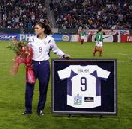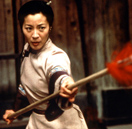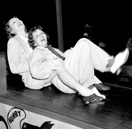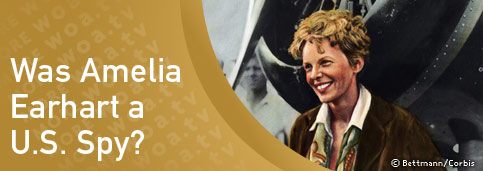
[Women] must pay for everything ... They do get more glory than men for comparable feats. But, also, women get more notoriety when they crash.
—Amelia Earhart
Many questions remain about Amelia Earhart’s quick and quiet disappearance somewhere over the Pacific Ocean in July 1937. Theories abound to explain the famous aviatrix’s mysterious exit, from the plausible (navigational error) to the absurd (abducted by a UFO). And though the FBI has never officially investigated the case, the federal agency has an online archive of more than 50 pages of correspondence from individuals speculating as to her fate. The stories there, and elsewhere, include accounts of unconfirmed sightings of Earhart living in obscurity in the Pacific Islands, New Jersey and Japan. Some say she faked her death so the press would leave her alone; others think that she was caught by the Japanese and forced to become Tokyo Rose, the English-language radio propagandist of World War II. Independent testimony from two U.S. servicemen even claims that Lady Lindy lived out the rest of her days as an amnesic South Seas prostitute with a craving for butter.
Chief among the chatter is the conviction that Earhart went down while on a mission for the U.S. government to fly over and photograph the Japanese-mandated islands of Truk (now Chuuk), Saipan and the Marshalls. This theory suggests that while on the most dangerous leg of her attempt to fly around the world, Earhart was shot down or simply crashed on one of the islands and was either executed instantly by Japanese soldiers or captured and taken to Saipan.
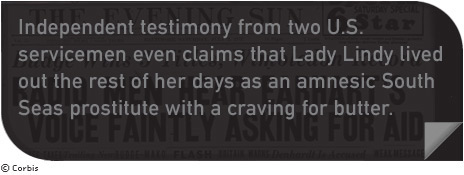
Though Earhart’s disappearance occurred four years before the United States declared war on Japan when the Japanese attacked the U.S. naval base at Pearl Harbor, relations between the countries were already strained. The scattered islands of the central Pacific would soon figure as a strategic battleground in World War II, and the U.S. government had reason to be concerned about Japanese war preparations. The espionage rumors about Earhart picked up steam in 1943 with the release of Flight for Freedom, a film clearly based on her life. The Hollywood romance stars Rosalind Russell as a well-known pilot and Fred MacMurray as her navigator. The pair intentionally crash-lands on an enemy island as a ploy to bring a government “search” for the aviatrix, which serves as a cover for the U.S. Navy to photograph Japanese territories. This film, more than any actual evidence, fanned speculation that Earhart was a U.S. spy, and contributed to rumors that Earhart and her navigator, Fred Noonan, were lovers.
Given the evidence (and lack of evidence), there are several gaping holes in the notion that Earhart was a government spy. The type of radar and electronic surveillance such a mission would require were not available in 1937, and the radio equipment in Earhart’s twin-engine Lockheed Electra plane was woefully out of date. In fact, Earhart opted not to take a trailing antenna (or parachutes) on her flight as they added too much extra weight. In order to take the photographs a spying mission would mandate, she would have needed an aerial camera mounted to her plane, which certainly weighed more than the parachutes she refused to carry. Furthermore, as Donald Goldstein asserts in his 1997 book, Amelia, Earhart “had never had an hour’s training in intelligence gathering, had no experience in photography beyond wielding the equivalent of a Brownie, and would not have recognized a military objective worth photographing if she tripped over it.”
Even if Earhart’s Electra plane had been equipped with an aerial camera, it would have required an elaborate, international conspiracy of mechanics, inspectors and foreign governments in order to keep it a secret. The Electra was repaired and inspected repeatedly during its global circuit. Someone along the way would surely have noticed the special equipment and reported it.
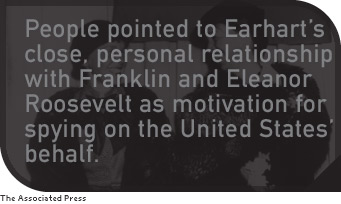 Additionally, Earhart was an odd choice for a covert mission; she was an international star who didn’t even know Morse code. A media darling, everything Earhart did was well publicized. The details of the flight path were hardly secret, and through newspaper and radio accounts, her movements as she circuited the globe were tracked by the general public—not a great setup for a secret agent.
Additionally, Earhart was an odd choice for a covert mission; she was an international star who didn’t even know Morse code. A media darling, everything Earhart did was well publicized. The details of the flight path were hardly secret, and through newspaper and radio accounts, her movements as she circuited the globe were tracked by the general public—not a great setup for a secret agent.
But more significantly, the around-the-world trip was already dangerous—adding the weight of surveillance equipment to a plane that could barely lift off under its fuel load would have meant almost certain death. Earhart was a patriot, but she was a pilot first, as well as a lifelong pacifist. Occasionally, people pointed to Earhart’s close, personal relationship with Franklin and Eleanor Roosevelt as motivation for spying on the United States’ behalf. This assertion pained Eleanor Roosevelt, and shortly before the first lady’s death she told Earhart’s sister, “Franklin and I loved Amelia too much to send her to her death.”
Sadly, the most likely scenario is the least interesting: The Electra simply ran out of fuel as Earhart and Noonan searched in vain for Howland Island. The plane, lightweight and empty of fuel, may even have bobbed on the surface of the ocean for several hours before it sank. The water in that area of the Pacific is 16,000 feet deep—and so far all attempts to recover wreckage or remains have failed. Until conclusive evidence is found, Earhart’s disappearance will continue to be one of the great mysteries of the twentieth century.
:: Erika Schickel



